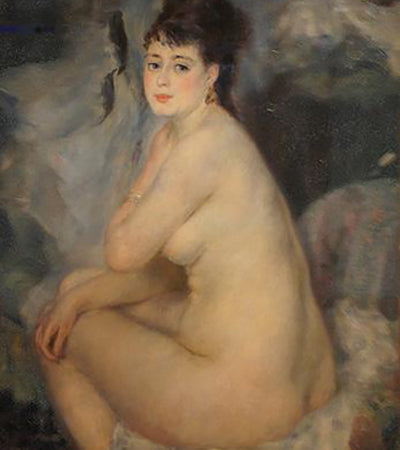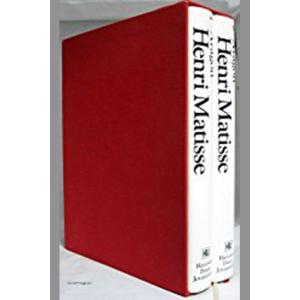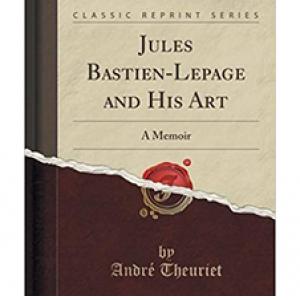The Amazing Story Behind the Collection
by Cathy Locke
To me going to a good museum is the equivalent of a child’s adventure to Disney World. Though I didn’t discover the Pushkin Museum of Fine Art in Moscow until my second trip to Russia, it ranks in the top ten museums in the world in my book. The Pushkin Museum’s collection consists of over 670,000 works that span three buildings, making it one of the largest museums in the world and the second largest in Russia after the Hermitage Museum. The museum has a wide variety of artwork, but it is most known for having one of the most expensive collections of nineteenth and twentieth century European art in the world. In the European building there is a world-famous collection of French paintings from the nineteenth to the beginning of the twentieth century, containing major works by Monet, Renoir, Degas, Gauguin, Van Gogh, Cezanne, Matisse, and Picasso. It is this building that I personally treasure as one of the dearest places on the planet. On display in the main building are masterpieces by Perugino and Botticelli, Cranach and Rembrandt, Rubens and Van Dyck, Ribera and Murillo, Poussin and Watteau, Constable and David. One of the main reasons for this incredible collection is due largely from the efforts of one woman, Irina Antonova, the museum’s director for the last 46 years. Irina has navigated her way through Russia’s social elite and political quagmires to secure numerous private collections.

In the entrance to the European art building at the Pushkin Museum there are two paintings by Pierre Bonnard on either side of the staircase (“Early Spring in the Country” and “Autumn”), as well as a series of sculptures by Aristide Maillol.
The Collection in The European Building
The European building of the Pushkin Museum primarily contains the private collections of three prominent business men of the nineteenth century: Sergei Tretyakov (1834-1892), Sergei Shchukin (1854–1936) and Ivan Morozov (1871-1921). Following the revolution of 1917 Lenin declared, in a decree dated March 5, 1918, that art collections along with properties in which they were housed were to be “protected on an equal basis to other government depositories of works of art and antiquity.” The newly-formed Soviet government now owned all of the private property owned by these three men and their heirs.

Edgar Degas, "Blue Dancers" (1898), 65" x 65", pastel on paper, Pushkin Museum of Fine Art, Moscow
Sergei Tretyakov was the younger brother of Pavel Tretyakov, the great collector of Russian art and the founder of the Tretyakov Gallery. Sergei Tretyakov concentrated on European art. He bought contemporary French art amassing the largest and best collection in Russia during his lifetime. His favorite artists were members of the Barbizon group that included Corot, Courbet and Millet. Upon his death in 1892 Pavel made a gift of both of their collections to the City of Moscow. It was the first fully public museum in Russia and it was called the City Gallery. The joint collection included 1,287 paintings, 518 drawings and nine sculptures. The “Russification” of the museum was the result of Lenin’s 1918 decree. All non-Russian art was moved out in order to suppress everything pro-Western. City Gallery was then renamed the Tretyakov Gallery and Sergei’s collection was put in storage for five years, then moved to the new State Museum of Modern Western Art.

Jean-Baptiste-Camille Corot, (left) "Pierrefonds Castle" (1860), 47"х 38", paper glued to wood, oil; (right) "Evening" (1870), 46" х 37", oil on canvas, Pushkin Museum of Fine Art, Moscow
Sergei Shchukin was a major patron of the impressionists and post-impressionists. It was Shchukin who encouraged Matisse to change his style in the early 1900s. Shchukin commissioned Matisse to paint two paintings of dancers for the foyer of his home in Moscow: Dance and Music. He then waited for four years as Matisse struggled to develop a new style upon which to paint his now famous paintings. Shchukin received the paintings in 1910, and then in 1918 he fled Moscow to save his life as Lenin stole all of his property. At that time the paintings in his home were stacked to the ceiling from the floor. Shchukin lost thirty-seven Matisse’s, sixteen Gauguin’s, eight Cezanne’s, fifty Picasso’s, sixteen Duran’s and four Van Gogh’s. His collection of Picasso's paintings featured choice works including most of his earliest cubist works, such as Three Women and major landscapes and some key pieces from his blue and rose periods. Irina Antonova once remarked about Shchukin, "He started to collect unpopular art, which was snubbed by the Louvre and other museums. It was his personal taste. Perhaps he heard foreshocks that would change the world. Such a collector could appear only in a country that awaited a revolution. He collected art that prefigured the global cataclysms."

Pablo Picasso, (left) "Young Acrobat on a Ball" 1905), oil on canvas and (right) "Portrait of the Poet Sabartes (The Tankard)" (1901), oil on canvas, Pushkin Museum of Fine Art, Moscow
Ivan Morozov’s sphere of interest encompassed the whole of French art over a thirty-year span from 1886 to 1916. The famous dealer Vollard described him as “the Russian who does not bargain.” “He is hardly off the train," wrote Felix Feneon, art director of the Bernheim-Jeune Gallery, "before you will find him at an art-dealer’s sunk deep in an armchair, made especially low so that it is difficult for him to get up, while canvases are paraded before him, like scenes from a film.” Morozov bought several of Monet’s works. He bought one of Monet’s Haystacks paintings from Fauré; then on the same trip Vollard dug out a rolled-up canvas in rather poor condition from his storeroom of similar proportions. Vollard sold it to him for a quarter of the asking price. Morozov realized that the two pictures were connected and indeed they had originally been painted as part of a series. Morozov acquired his first paintings by Gauguin and Cezanne in 1907. He was so deeply moved by the paintings of Van Gogh that he purchased Cottages, Landscape at Auvers after the Rain and Night Café. At the beginning of the twentieth century there is no doubt whatsoever that Morozov’s Cezanne collection, consisting of eighteen masterpieces, was the finest in the world. The famous Russian artist, Valentin Serov, also advised Ivan Morozov on what paintings to buy. Serov told Morozov to turn down Manet’s wonderful landscape, Rue Mosnier with Flags. Serov did recommend Van Gogh’s famous Red Vineyards at Arles and the Prisoners’ Round. The painter Denis introduced Morozov to Aristide Maillol, from whom the collector commissioned four figures for the Psyche hall in his home. Serov wrote to Morozov from Paris: “yesterday I saw the two Maillol statues made for you. They are very good – but the one with fruits is magnificent. This is real sculpture, original and complete.”

Paul Cezanne, (left) "Peaches and Pears" (1895), 61" x 90", oil on canvas; (middle) "Pierrot and Harlequin" (1888-1890), 102" x 81", oil on canvas; (right) "Bridge Over Pond" (1898), 64" x 79", oil on canvas, Pushkin Museum of Fine Art
In 1923 the collections of Sergei Tretyakov, Sergei Shchukin and Ivan Morozov were merged and became part of the collection of the new State Museum of Modern Western Art. Part of its collection was handed over to the Hermitage and some of the best works of art were secretly sold to Western buyers carried out in Berlin. Fortunately for the collection, Hitler’s rise to power meant that Russia could no longer trust Germany and all sales were halted. In the 1930s Stalin decreed that these paintings contain no educational value and with the outbreak of WWII all of the paintings were evacuated to Siberia. Large canvases were rolled up and remained in this state for many years; this includes Matisse’s Dance and Music. During the war the Nazis heavily bombed all of the museums in Russia. Had these paintings not been shipped to Siberia they all probably would have been destroyed. After WWII the paintings returned to Moscow where they were divided up between the Pushkin Museum, the Hermitage and several provincial museums. Some paintings were destroyed completely. The Pushkin Museum got the very best of the paintings except for Shchukin’s collection of cubist works by Picasso that were handed over to the Hermitage without a tear shed. Now enriched beyond imagination, the Hermitage was unable to display a single one of the paintings it had received. For a long time they were kept in "Storeroom A" where they could be viewed only by a few artists who were able to pull strings. It was virtually an act of suicide to exhibit new Western art during Stalin’s lifetime. The very outspoken Alexander Gerasimov, the first president of the newly founded Academy, said, “If anyone dares to exhibit Picasso, I’ll hang him!” It was only after Stalin’s death in the mid-1950s that little by little this art became accessible to the public. Unfortunately, by then many of the paintings were declared "anti-national" and had been destroyed.

Vincent van Gogh, “The Prison Courtyard” (1890), 80" × 64", oil on canvas, Pushkin Museum of Fine Art
The Collection in the Main Building
Planning for the original museum started in 1898 with what is the main building today. Originally the museum was named the Alexander III Museum of Fine Arts after Tsar Alexander III. The museum was affiliated with the Moscow University and it was intended to be a teaching museum. A committee was created consisting of the University’s professors to plan the creation of the Museum. The committee continued to exist until February 1917. The starting point for the Museum's collection was Moscow University's "Cabinet" (Museum) of Fine Arts and Antiquities, which included Greek vases, a numismatic collection, a number of casts taken from works of classical sculpture and a small specialist library. Professor Tsvetaev expanded the collection to include a huge collection of plaster casts that are still available for art students to draw today. The main building to the museum was designed to introduce students and visitors to the main stages in the history of art from ancient civilizations up until the sixteenth century. Sections were created in the museum that are copies of both architectural elements and sculpture depicting these ancient civilizations. This concept made the Pushkin Museum the first institution of its kind. The creators of this museum envisaged it as a temple to the Muses, which would provide an idea of the classic periods of world art. The façade of the building is embellished by an Ionic colonnade based on the proportions of the famous Erechtheion temple on Athens’ Acropolis. Inside the museum, German sculptor K. Armbruster reproduced parts of the renowned ancient Greek temple – the Parthenon. There are rooms upon rooms of high-quality casts and exact copies of Greek and Roman original sculptures. One of the jewels of the museum's collection is its unique collection of original works of ancient Egyptian art and cultural artifacts (over 6,000 in total).

Vincent Laurensz van der Vinne, "Vanitas" (1625-1702), oil on canvas, Pushkin Museum of Fine Art
The Alexander III Museum of Fine Arts opened on June 13, 1912. Tsar Nicholas II and Dowager Empress Maria Fyodorovna attended the opening ceremony. In 1932 the museum was renamed the State Museum of Modern Western Art and in 1934 the name of the great Russian poet, Alexander Pushkin, was added to its full title – the Pushkin State Museum of Fine Arts. By this time the museum had also acquired over 1,000 cuneiform tablets and approximately 3,000 other ancient-Egyptian objects from the former Museum and Research Institute of the Classical Orient. A gallery of paintings from the eighth to the twentieth century was created in the main building. This collection includes works by European Old Masters, Byzantine icons and ancient mosaics, and works by West-European and American painters and sculptors of the nineteenth and twentieth centuries. The principle behind these exhibitions is to demonstrate the nature of national schools of painting and the succession of one era after another in the world of art.

Juriaen van Streeck, "Vanitas: Still Life with Feather Fan" (c.1670), 38.5" x 33", oil on canvas, Pushkin Museum of Fine Art, Moscow
There are works at the Pushkin Museum whose legitimacy of ownership is questionable through the booty of war and revolution. During World War II, Germany bombed the museum completely destroying the ceiling throughout the entire structure of the main building. After World War II for “cultural restitution,” Russia emptied out the Dresden Gallery and appropriated works from other German museums. Though the majority of those works were eventually returned, the main building of the Pushkin Museum is still a depository of the majority of the fabulous gold looted from Troy by the German archaeologist, Heinrich Schliemann, and then taken by the Soviet Army from the Pergamon Museum in Berlin.

Willem Kalf, "Still Life with Cup of Pearl Shell" (1662), oil on canvas, Pushkin Museum of Fine Art
Location
14 Volkhonka Street, Moscow, Russia
Sources
Albert Kostenevich, French Art Treasures at the Hermitage, Harry N. Abrams, Inc., Publishers
The Pushkin Museums websites: www.newpaintart.ru and www.arts-museum.ru
French Art Treasures at the Hermitage by Albert Kostenevich, published by Henry N. Abrams, Inc
About the Author
Cathy Locke is an award-winning fine art painter, professor, and published writer, specializing in Russian art of the 19th and 20th centuries. She is the editor of Musings-on-art.org.
Cathy Locke’s artwork – www.cathylocke.com













